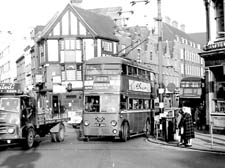|
|
 |
| |
Take a trolley bus ride to Lyons corner house
Gerald Isaaman tastes a rich cocktail of memories in a new book that explores landmarks of London that no longer exist
The London We Have Lost.
By Richard Tames
Historical Publications £22.50.
RICHARD Tames remembers riding on a trolleybus, shopping in Gamage’s, drinking from London street fountains and buying cakes at Joe Lyons.
And he recalls: “Perhaps Biba’s never was destined to look as rock-solid as Baring’s. But they both imploded. Bloom’s replaced by a Burger King. I can still hardly credit it.”
Trams too were around in my early days, along with trolleybuses, as were Waring and Gillow and Swan and Edgar, now lost West End stores, along with Whiteleys in its pre-shopping centre days.
So it is enticing to pick up Tames’s book and enjoy his collected cocktail of more than 400 services and places in our capital city that no longer exist.
Some of the entries are perhaps somewhat futile. Why should we want to remember places of public execution, leper hospitals, muffin men, sedan chairs, cock-fighting, bear-baiting, highwaymen and even duelling grounds?
But as Tames – a London Tourist Board blue badge guide – succinctly observes: s“Much of what we have lost is, therefore, no loss at all... And yet so much of London’s past is not so much lost as simply forgotten so completely that it might never have been.
“The de-industrialisation of the metropolitan economy has virtually expunged from popular memory any awareness that London was once actually a place where things were made.”
So, he can recall shipbuilding the Thames, industries such as silk-weaving in the East End and the manufacture of tapestries, porcelain, carriages, pianos, matches and even the Maxim machine-gun.
Such is the movement of history and civilisation. Indeed, few companies ever exist for more than a century, the more so if they are not taken over and new blood injected.
Buildings as well as businesses disappear. When you think about the City we now behold, not that long ago, St Paul’s Cathedral held the height record.
Nevertheless, it is worth going walkabout in the past, either on the page or the pavements to look for the oddities now missing. For example, Hummums’ in Covent Garden, named after the Arabic for bath, described as a “bagnio or sweat house opened by Robert Lazenby in 1681 on Russell Street”. It later became a hotel and is, today, Tutton’s Bar. Or there is Pitt House, in North End, Hampstead, where the Earl of Chatham (1708-78), suffering from periodic bouts of mental anguish, locked himself away from the political heartache of his day. The property later became the home of Harold Harmsworth, subsequently the press baron Lord Rothermere, until being demolished in 1952.
Islington once had its own fashionable spa, at the chalybeate spring opposite Sadler’s Wells, where, for a modest admission fee of three pence, you amuse yourself dancing, taking coffee or strolling through shaded walks of rustic arbours.
“In 1732-3, Islington enjoyed the pinnacle of its popularity thanks to the patronage of George II’s daughters, the Princesses Amelia and Caroline,” reports Tames. “Islington remained a rural retreat, celebrated for its cows, cream, cheesecakes and custards until the first decade of the 19th century, when suburban terrace-building began.”
The book is arranged alphabetically and is packed with fascinating prints and pictures, all of which makes it an excellent Christmas present for the curious, who will find it an admirable guide. |
|
 |
|
 |
| |
|
 |
|



